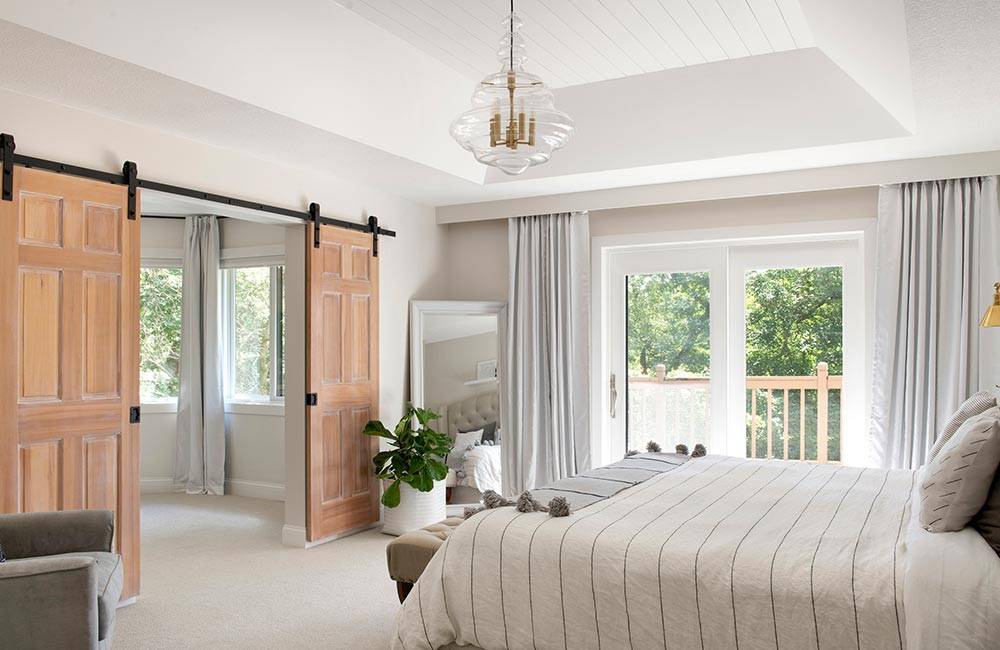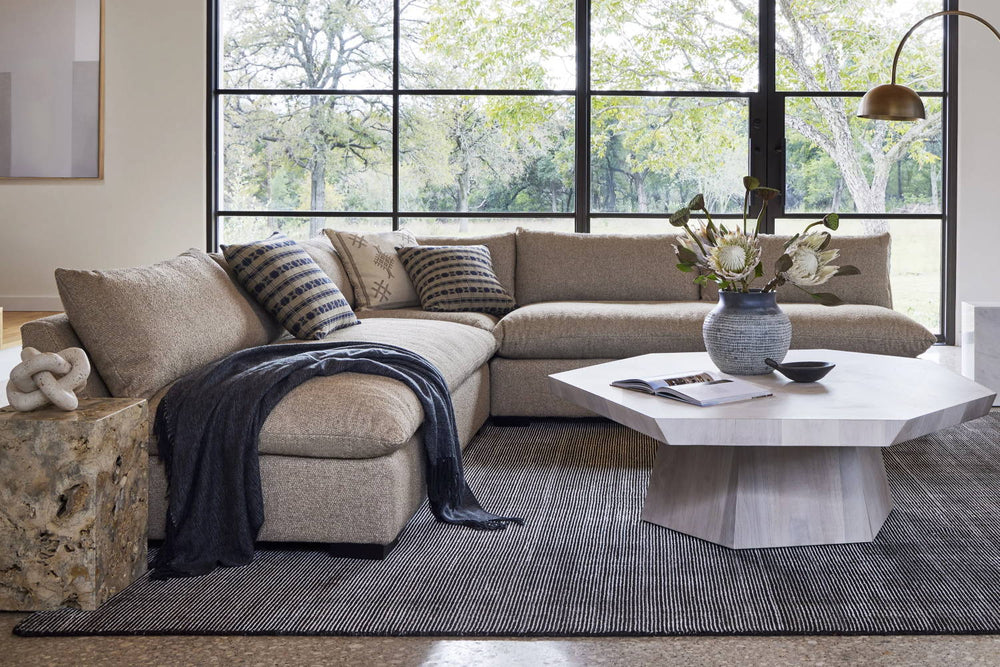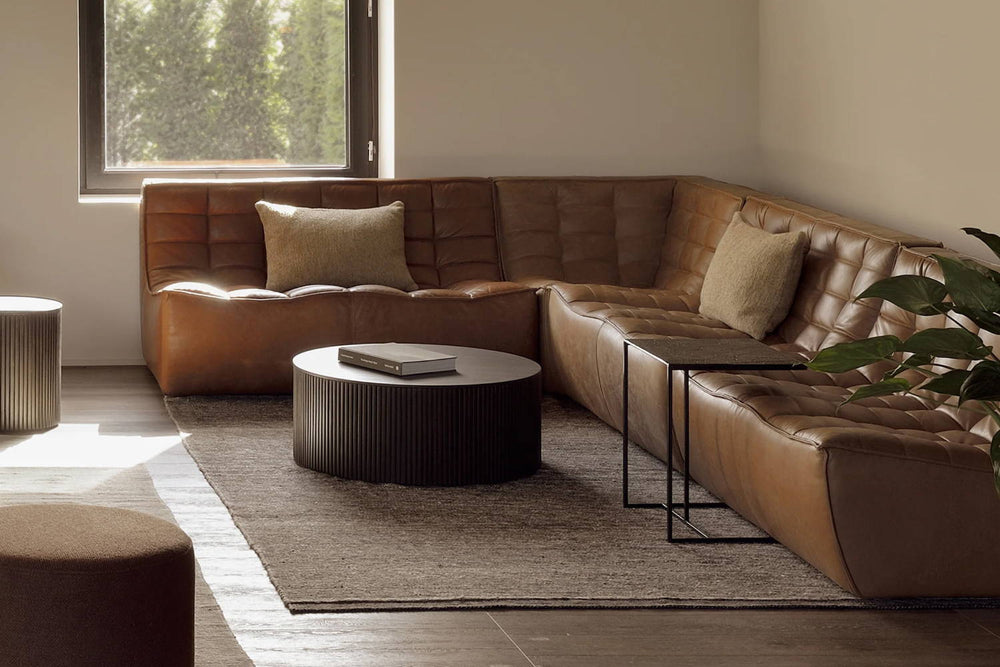CH337 Dining Table by Carl Hansen & Son
When it comes to furnishing small spaces, every inch counts, and choosing the right modern dining table can make a significant difference in maximizing both functionality and aesthetics. One often overlooked but highly versatile option for small dining areas is the round dining table. In this guide, we will delve into the advantages of round dining tables for compact spaces, discussing how they can enhance both the practicality and style of your home. From their space-saving design to their ability to foster intimate gatherings, round dining tables might just be the perfect solution for those seeking to make the most of limited space without compromising on elegance and functionality. Join us as we unravel the charm and efficiency of round dining tables in the context of small living spaces.
Snaregade Round Table by Audo Copenhagen
Round Dining Tables: Perfect for Small Spaces
Round dining tables offer several benefits that make them a popular choice for smaller spaces:
- Efficient Use of Space: Round tables often have a smaller footprint compared to modern rectangular or square tables of similar seating capacity. This space efficiency makes them ideal for smaller dining areas, as they maximize the usable space in the room
- Flexible Seating Arrangements: The absence of corners on a round table allows for flexible seating arrangements. Everyone has equal access to the table's surface, making it easier to accommodate additional guests when needed. This adaptability is particularly advantageous when hosting gatherings or events
- Enhanced Social Interaction: Round tables promote better conversation and social interaction. With no one sitting at the head or foot of the table, all diners are in close proximity to one another. This arrangement fosters a sense of intimacy and encourages natural conversations during meals
- Safety for Small Children: The absence of sharp corners on round tables makes them a safer option, especially in homes with small children. Parents can worry less about children accidentally bumping into sharp edges
- Facilitates Serving and Passing Food: When dining at a round table, passing dishes and serving food is more convenient as everyone is within reach. This can make family-style or shared meals more enjoyable
- Ideal for Smaller Dining Areas: Round tables are especially well-suited for smaller dining areas where space optimization is crucial. Their compact design and efficient use of space can make a room feel more open and less cramped
Whether for small or large dining spaces, round tables provide a versatile and visually appealing option for homeowners and can contribute to a more welcoming and comfortable dining experience.
Corto Dining Table by Ethnicraft
Square Dining Tables: Ideal for Square Rooms
Square dining tables also come with their own set of advantages, making them a popular choice for many homeowners:
- Symmetry and Balance: Square dining tables provide a sense of symmetry and balance in a dining space. The equal sides and right angles can create a structured and organized look, which appeals to those who prefer a more formal or orderly aesthetic
- Efficient Seating Arrangement: Square tables are efficient in terms of seating. Each side can accommodate an equal number of diners, making it easy to set up seating for a fixed number of people, such as a family of four or eight
- Space Utilization: In square dining rooms or spaces, square tables can fit neatly into corners or align with the room's walls, optimizing the use of space. This is particularly advantageous in rooms with limited floor space
- Suitable for Small and Large Groups: Square tables can comfortably accommodate both small and large groups. You can choose the table size that suits your typical dining needs, and if necessary, add extra modern dining chairs for larger gatherings
- Easy Conversation: Square tables facilitate conversation among diners, as everyone is seated closer to each other, much like round tables. This setup encourages interaction and socializing during meals
- Ideal for Games and Activities: Square tables are versatile and can be used for more than just dining. They are great for board games, card games, puzzles, or other family activities, providing a dedicated space for entertainment
- Well-Defined Dining Area: A square dining table can define a clear dining area within an open-plan living space. Its symmetrical shape helps delineate the dining space from other areas in the room
Square dining tables offer advantages such as symmetry, efficient seating arrangements, space utilization, suitability for various group sizes, easy conversation, versatile styling, and a contemporary look. The choice between a square, round, or rectangular dining table ultimately depends on your personal preferences, available space, and the overall design aesthetic you want to achieve in your dining area.
Slice Extendable Dining Table by Ethnicraft
Rectangular Dining Tables: Best for Large Gatherings
Rectangular dining tables are a popular choice for many dining spaces due to their versatility and practicality:
- Space Efficiency: Rectangular tables make efficient use of space, especially in long and narrow dining areas or rooms with limited floor space. They can be placed against a wall or in the center of the room, optimizing the layout
- Accommodates More Diners: Rectangular tables typically have a longer tabletop, allowing them to accommodate more diners than round or square tables of similar dimensions. This makes them suitable for larger gatherings and family dinners
- Defined Seating Arrangement: The linear shape of rectangular tables creates a clear and defined seating arrangement. This can help maintain order and structure in the dining area, especially when hosting guests
- Multipurpose Use: Rectangular dining tables can serve multiple purposes beyond dining. They can be used as a workspace, a homework area for children, or for playing board games and card games
- Easier for Serving: Serving food and beverages on a rectangular table is often more straightforward than on a round or square table, as you can arrange dishes along the length of the table
- Suitable for Small and Large Rooms: Rectangular tables work well in both small and large dining rooms. You can choose the size that best fits your available space and seating needs
- Compatible with Bench Seating: Rectangular tables are well-suited for bench seating along one or both sides, which can save space and provide a cozy dining experience
Rectangular dining tables offer benefits such as space efficiency, the ability to accommodate larger groups, versatility in styles, a formal ambiance, defined seating arrangements, multipurpose use, and compatibility with various room sizes. Your choice of dining table shape ultimately depends on your personal preferences, available space, and the overall aesthetic you want to achieve in your dining area.
Marcon Dining Table by Four Hands
Factors to Consider When Choosing a Dining Table Shape.
Choosing the right dining table shape is essential for creating a functional and visually pleasing dining area. Several factors should be considered when making this decision:
- Room Size and Layout: Measure your dining space carefully to determine the available room dimensions. Consider the shape and layout of the room, including any architectural features, doors, windows, and traffic flow. Choose a table shape that fits comfortably within the space, allowing enough room for chairs and movement around the table
- Number of Diners: Consider the number of people you typically host for meals. Different table shapes can accommodate varying numbers of diners. Ensure that the table you choose can comfortably seat your household and any guests you anticipate having
- Dining Style: Think about your dining style and how you plan to use the table. Do you host formal dinner parties, casual family meals, or a mix of both? Some shapes, like rectangular tables, often convey a more formal atmosphere, while others, like round or square tables, can create a cozier, casual feel
- Space Efficiency: If you have limited space, consider the efficiency of the table shape. Round and square tables are generally space-efficient and work well in smaller rooms, while rectangular tables are more space-efficient in longer, narrower spaces
- Seating Arrangement: Think about how you want your diners to be arranged. Round and square tables encourage conversation among all diners, while rectangular tables create a more linear seating arrangement. Consider which seating arrangement aligns with your preferences
- Intimacy and Interaction: Consider the level of intimacy and interaction you want during meals. Round tables tend to foster more interaction due to their circular shape, while rectangular tables can create a sense of formality and structure
- Safety: If you have young children, consider safety concerns. Round tables and tables with rounded edges may be safer for kids than those with sharp corners
Remember that there is no one-size-fits-all answer, and the best dining table shape for you depends on your unique circumstances, preferences, and the specific requirements of your dining space. Taking these factors into account will help you make an informed decision and find the perfect dining table for your needs.
Brennan Dining Table by Four Hands
Capacity: Round vs Rectangular Dining Tables
The seating capacity of round and rectangular tables can vary based on their size and the number of people you want to accommodate comfortably. Here's a general comparison of the seating capacity for both table shapes:
Round Tables:
- Round tables are typically more space-efficient than rectangular tables because they lack corners, allowing diners to sit closer together
- The seating capacity of a round table can range from 2 to 12 or more people, depending on its diameter
- A small round table with a diameter of around 36 inches can comfortably seat 2 to 4 people
- A larger round table with a diameter of 48 to 60 inches can accommodate 4 to 8 people
- For even larger gatherings, round tables with diameters exceeding 60 inches can seat 8 to 12 or more people, but keep in mind that these may require a larger dining space
Rectangular Tables:
- Rectangular tables are longer and narrower, which can affect their seating capacity
- A small rectangular table, often referred to as a bistro or cafe table, can seat 2 to 4 people
- A standard rectangular dining table that measures approximately 36 inches in width and 60 inches in length can comfortably seat 4 to 6 people
- Larger rectangular tables, such as those measuring 42 inches by 72 inches or 48 inches by 96 inches, can seat 6 to 10 people or more, depending on their size
It's important to note that the seating capacity mentioned above is a general guideline and can vary depending on the specific design and leg placement of the table, the size of the chairs, and the amount of space you want between each diner for comfort. Additionally, you should consider the room's layout, traffic flow, and the space needed for guests to move chairs and access their seats comfortably.
Hven Round Dining Table by Fritz Hansen
Round dining tables can indeed be a superb choice for small spaces, offering a combination of space efficiency, versatile seating arrangements, and an intimate atmosphere. Their ability to optimize room layout, foster conversation, and provide a stylish focal point makes them a valuable addition to compact dining areas. However, whether round dining tables are "better" for small spaces ultimately depends on your specific preferences, room size, and intended use. As with any modern furniture selection, careful consideration of your needs, available space, and personal style will guide you towards making the perfect choice for creating a welcoming and functional dining space in your home.








